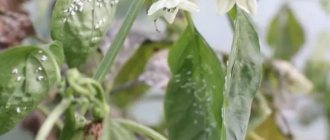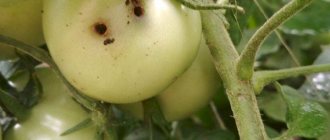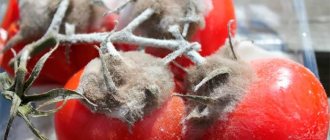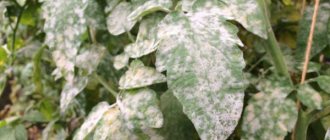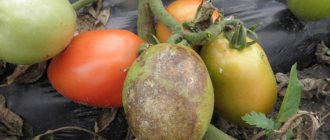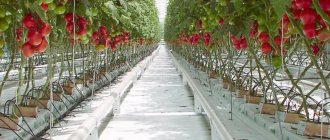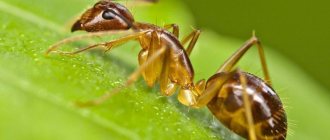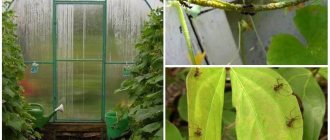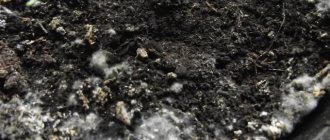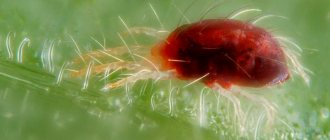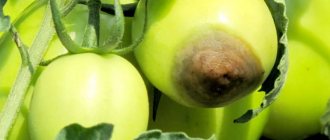The topic of how to deal with whiteflies in a greenhouse is of interest not only to novice gardeners, but also to people who have extensive experience in plant growing. The rapid reproduction of the insect leads to the fact that the plant does not receive enough moisture and useful components and begins to wither. There are many ways to get rid of it, from manual collection or spraying with pesticides, to setting up traps or introducing antagonistic insects (predators).
Tomatoes affected by whitefly Source stopklopu.com
What is whitefly
Trialeurodes vaporariorum or the greenhouse whitefly is a flying insect that belongs to the genus Ileuroids. Externally, this pest looks like a small moth with a small yellow body (up to 1.5 mm in length) and four small white wings, covered with a powdery coating, which fold into one plane.
An adult female lives no more than a month, during which she is able to lay up to 130 eggs with an average size of 0.25 mm. The whitefly lays clutches on the reverse side of leaf blades, arranging them in concentric circles. Each of these circles can have up to 30 eggs. Initially their color is greenish with a yellow tint, gradually they darken and eventually become almost black.
The hatched larvae are flat, oval in shape, and light green in color. They go through 4 phases of development, growing during this time from 0.9 to 0.9 mm. In the first phase, the larvae are unusually mobile and voracious; they quickly move from leaf to leaf, from plant to plant, actively sucking cell sap from the leaf plates. During this period, they need abundant nutrition, after which a sticky secretion remains on the foliage - a product of their vital activity.
After entering the second phase, the larvae become motionless, but also eat a lot. In total, the first three phases of the larvae pass in about 2 weeks.
In phase 4, whitefly larvae are covered with a special waxy coating and become invulnerable to even the most powerful insecticides. This phase lasts up to 2 weeks, then adult flying individuals emerge from the larvae.
If greenhouses are heated in winter, then the whiteflies living in them can produce 4 generations over the entire calendar year. Favorable conditions for their reproduction: temperature around +22+26०С and humidity 61-75%.
Important! In the climatic conditions of the middle zone and other regions with similar winters, the whitefly cannot overwinter in the ground, but can wait out the cold in greenhouses or on indoor flowers.
Biological description of the pest
Many types of whiteflies are similar in appearance and have the same development cycle. In temperate climates, cabbage whitefly can most often be found on garden crops.
And in greenhouses and hothouses, almost everywhere, the greenhouse whitefly is found. It harms many protected soil crops: tomatoes, cucumbers, peppers, herbs and others. Due to the adaptability of feeding on various crops, it is a polyphage.
Description
The body of an adult insect is very small, no more than 2 mm in length, with a width from 0.3 to 0.7 mm. The color is light, yellowish with noticeable dark spots on the sides of the head, chest and abdomen. The number of wings is 4. Their surface is covered with a whitish, flour-like coating, and the body of the pest is also covered with it. It was he who gave the name to these insects. At rest, the wings are folded at an angle.
Mustache
A pair of antennae extend from the front of the head. The first two segments are spherical, the next five segments are thin and long. There is a hair on the last one.
On the third, fifth and seventh segments there are special sensory organs or rhinaria. In whiteflies they are small, round with numerous cilia.
Other organs
Whiteflies have a pair of eyes. They are complex with a constriction that divides them into dorsal and ventral parts. The mouthparts or proboscis are of the piercing-sucking type.
The insect has six long legs. On the second segment there is an unpaired outgrowth or paronychia.
At the end of the body you can find the anus. It is located on the dorsal side. It looks like a cup with a tongue inside, covered with a lid.
The whitefly has four pairs of spiracles that open outward. Two on the abdomen and chest. They serve to bring air into the trachea of the insect.
Sexual dimorphism
Females differ from males in the structure of their genital organs. Females have an ovipositor at the end of their abdomen. It looks like a thin chitinous tube that is used for laying eggs.
Males have a copulatory organ on the last abdominal segment. It is needed for copulation with females.
Why is whitefly dangerous for tomatoes?
These insects actively feed on the cell sap of any vegetable plants, including tomatoes, thereby causing enormous damage to these crops. In addition, they leave behind a sweet waste product - honeydew, which attracts many other harmful insects.
Following this small butterfly, ants can settle on tomatoes. And the indispensable companion of whiteflies is a sooty fungus, which also causes enormous harm to cultivated plants.
The main ways whiteflies can harm you are as follows:
- this pest and its larvae suck out too much cell sap from plants, which negatively affects the condition of garden crops;
- as a result, the foliage quickly turns yellow, dries and falls off ahead of schedule;
- whiteflies can cause ants to settle on tomatoes;
- The sweet secretions of whiteflies are the main reason for the appearance of sooty fungus on plants, which covers the leaf blades with a black coating that clogs the stomata. As a result, sunlight does not reach the leaves, photosynthesis stops in the vegetative mass, which makes it impossible to process incoming nutrients;
- fruits slow down ripening, white veins appear in their pulp, which impair the taste and appearance of ripe tomatoes;
- whiteflies often carry viral diseases for which there is no treatment, so affected vegetable crops have to be removed and destroyed;
- Cultivated plants affected by whitefly slow down their growth and development, sometimes they simply stop developing, and in the worst case, they die.
Important! If a whitefly settles on seedlings, they most often die because they do not have enough strength to resist the pest. Seedlings are also vulnerable during the period of acclimatization in a new place immediately after transplantation.
Reasons for appearance
Whiteflies do not appear on plants out of nowhere. In the southern regions of the country, this harmful flying insect overwinters quietly in the soil, from where it flies out in the spring and flies from plant to plant or is carried by the wind. And their larvae can only move from plant to plant within one area.
In Russian regions with colder winters, whiteflies do not overwinter in the soil, as they will simply freeze there. Therefore, for the winter they move to heated greenhouses or conservatories, to compost heaps, or settle in indoor and greenhouse plants.
This butterfly can enter greenhouses through cracks, open doors or transoms during ventilation.
Often whitefly larvae end up in the garden plot along with purchased seedlings. Not too conscientious buyers can use a jet of water to knock down the adult individuals of this harmful insect, but the larvae cannot be removed so easily, because they are firmly attached to the foliage.
Also, this pest often enters greenhouses along with contaminated soil. Often when replacing topsoil with new soil, vegetable growers do not disinfect the new layer of soil before placing it in the beds due to its large volume. As a result, whiteflies begin their harmful activities, which can lead to the death of plants and crops.
And even in an unheated greenhouse, several individuals of this pest can survive after winter and quickly reproduce in comfortable conditions.
The greenhouse whitefly can damage all vegetable crops from the nightshade family, cucumbers and flower crops grown at home or in greenhouses. It can later move onto weeds and become a source of re-infection of vegetable crops. If whitefly larvae, together with the remains of vegetation, end up in the compost, then they successfully overwinter there, turn into adults, and in the spring, together with compost fertilizer, they end up in garden beds in greenhouses and film greenhouses.
This insect causes more harm to weakened plants - vegetable growers often notice that there are many whitefly larvae swarming on weak, sluggish plants, while there are practically no whitefly larvae on strong and healthy tomato bushes. This happens because it is much easier for these harmful insects to bite through a flaccid leaf blade than a strong, healthy leaf.
If vegetable growers do not follow the rules of agricultural technology, then this cannot be the main reason for the appearance of these pests on plants. However, tomatoes that have not been properly cared for become weaker and more vulnerable to whiteflies and their larvae. And since it takes a long time to fight these harmful insects, the affected tomato bushes often do not live to see complete victory.
Signs of defeat
The whitefly is clearly visible on the foliage of affected plants and it is impossible to confuse it with any other pests.
The main symptoms of the appearance of this harmful insect on tomato bushes are as follows:
- if the colony of whiteflies has grown too large, then when you touch the affected plant, a large number of small butterflies rise into the air;
- On the reverse side of the foliage, a large number of larvae, similar to small white sticks, are clearly visible. They are easy to wash off and erase in the first stages of development. At the last stage, the greenish larvae are covered with a special waxy coating and are tightly attached to the surface of the foliage;
- the affected leaf blades become sluggish, quickly become covered with small spots of light color, traces of whitefly activity appear on their surface, then the foliage may curl, turn yellow and fall off;
- often a sooty fungus appears on the surface of the foliage, which covers the outer part of the leaves with a black coating;
- affected tomatoes practically do not grow and begin to wither;
- In ripe fruits of affected tomatoes, white veins appear inside.
Ways to fight
You can fight this pest in different ways, but you need to keep in mind that even the most effective chemicals will not always be able to immediately deal with whiteflies.
Thus, the larvae in the last stage of development are covered with such a durable coating that almost all known insecticidal agents cannot destroy. But such preparations cannot be used too often to process tomatoes, since they accumulate in the foliage and fruits, which then cannot be eaten.
It will take a long time to fight this pest, using different types of drugs at the same time. Moreover, they will be most effective when the whitefly has just arrived on the tomatoes from other plants.
Traps
You can hang special glue traps above or next to the affected plants - these are special cardboard boxes with holes on which odorless glue is applied.
All such traps are brightly colored, so various pests, including aphids and whiteflies, flock to them. One trap is effective over an area of 10 square meters. m.
Mechanical methods
Of the mechanical methods in the fight against whiteflies, the most effective are fumigation, washing with water, removing with water or using fumigators.
Fumigation
Usually in greenhouses special sprays against blood-sucking insects (repellents) are used for fumigation. They are sprayed on the paths and walls of greenhouses, then the windows and doors are closed and left closed for several days.
Washing with water
Butterflies and larvae in the first stages of development can be washed off from plants with the pressure of a stream from a hose.
Manual removal
With proper care, there is not too much foliage on the tomato bushes, so until the colony of whiteflies has grown, these pests can be picked manually and destroyed outside the site.
Fumigators
You can get rid of whiteflies in a greenhouse by installing fumigators with special plates or liquid next to the affected plants. In this case, all doors and windows in the greenhouse must be closed.
Important! While fumigators are operating, people should not be in the room to avoid inhaling toxic fumes.
Chemicals
Chemicals are most effective in controlling these harmful insects.
Malathion
This drug is effective against sucking and gnawing pests. When harmful insects enter their body, they die quite quickly.
Cypermethrin
This drug has an intestinal contact effect on pests. It contains the only active substance cypermethrin (250 ml/1 l). When ingested by pests, it affects their nervous system, causing paralysis and rapid death of whiteflies and larvae.
Pirimiphos methyl
This drug has a systemic contact-intestinal effect on pests. Accumulating in their bodies, the insecticide disrupts the functioning of their internal organs. which leads to a fairly rapid death of harmful insects.
Acetamiprid
After treating cultivated plants, this drug quickly penetrates their tissues and spreads throughout the plant. The drug enters the body of insects through direct contact or after pests eat poisoned cell sap or plant parts. The product has a negative effect on their nervous system; as a result, whiteflies and their larvae die from paralysis and nervous overexcitation.
Imidacloprid
This product has a contact-intestinal effect on harmful insects. The product penetrates the central nervous system of pests, disrupting its functioning. As a result, the insects die due to paralysis.
Thiamethoxam
This drug is a systemic insecticide, characterized by a contact-intestinal effect on pests. Entering the body of harmful insects through the integument, trachea and intestines, the product turns into clothianidin, which is toxic to insects, which is a strong nerve poison for them, causing the rapid death of poisoned harmful insects.
Folk recipes
Folk remedies are most effective at the moment when whiteflies have just appeared on tomato bushes. To combat this pest, infusions and decoctions based on various plants, as well as glue traps, are used.
Herbal infusions and herbal decoctions
Of the herbal infusions and herbal decoctions, the most effective are the following:
- Soap solution. It is prepared in the following way: dissolve 20 g of grated laundry soap in a liter of heated water, which is completely dissolved. This solution should be used to wipe the foliage of plants several times a day until the whiteflies completely disappear. This method can be used until the pest colony has grown too much.
- Vinegar solution. Dissolve 10 tsp in 10 liters of water. vinegar and a couple of tbsp. l. liquid soap for better adhesion of the solution to the foliage. Tomatoes are treated with this solution once a week; as a result, whiteflies will fly away from such treated plants for good.
- Garlic infusion. To prepare such a solution, 2 cloves of garlic are crushed and poured with a liter of warm water. The product is infused for 24 hours, then filtered. Plants and the root zone are treated with this infusion three times a season, with a week between treatments.
Glue traps
Glue traps can be purchased in specialized stores or made independently. To do this, colored cardboard is smeared with odorless glue and hung or laid out over tomato bushes. Whiteflies flock to the bright colors and stick to the cardboard.
Biological methods
Biological treatment methods are equally effective at different stages of whitefly infection of tomato bushes. However, if the colony of these pests is too large, then it is much more effective to carry out several sprayings with special insecticides.
Verticillin
Verticillin is a biological preparation that contains special beneficial fungi. The working solution is prepared as follows: 100 ml of the drug is dissolved in a bucket of water and infused for several hours, then tomato bushes and soil can be sprayed.
Ladybug
The ladybug is a natural enemy of whiteflies, as it eats their larvae as well as adults. In a greenhouse measuring 6*2 meters, it is worth introducing 10-12 ladybugs, which will quickly deal with the colony of whiteflies on tomatoes.
Lacewing
The lacewing fly also feeds on these harmful insects, so it is worth breeding in the garden if there are whiteflies there. Such flies are quite voracious, so they are able to quickly clear an area not only of whiteflies, but also of aphids and some other pests.
Encrasia
Encrasia lays its eggs in the body of whitefly larvae. And when tiny wasps hatch from them, they feed on the body tissues of the larvae. Adult encrasias live for about a month and during this period can eat up to 15 adult whiteflies. To prevent the colony of these pests from growing, it is enough to plant 5 of these wasps in a greenhouse.
Macrolophus
This predator feeds on whitefly eggs and larvae. Each adult macrolophus lives up to a month, during which time it is able to eat up to 3000 eggs and 2000 whitefly larvae. On each square of area it is enough to have up to 7 adult individuals of this predator.
Traps - glue traps for flying and crawling creatures
You can get rid of whiteflies by hanging special glue traps over the affected plants. They are produced by many, "ARGUS", "Bona Forte", etc. Traps are small sheets of cardboard or plastic, covered with a layer of non-drying glue. It is colorless and odorless, non-toxic.
The traps are painted bright yellow to attract whiteflies. Insects stick when they touch the adhesive surface, even the lightest. By the way, in addition to whiteflies, other pests can also get caught in the trap: fungus gnats, miner flies, aphids, thrips and even spider mites.
Bona Forte traps help get rid of adult whiteflies, and over time completely destroy their population
Traps are not such a complicated device, so if you wish, you can make them yourself. To do this, you need to take pieces of thick cardboard, paint them bright yellow and cover them with Vaseline, a mixture of honey and rosin, and castor oil. Instead of cardboard, you can use plywood or hardboard.
Traps are secured to a wooden, plastic or metal holder and placed in a pot with the affected plant. Many traps come with wire mounts that hang above the crown of the plant. If a whitefly appears in a greenhouse, then it is enough to place traps at the rate of 1 piece. per 10 m2. At home, you need to install a trap on each windowsill.
It should be remembered that the adhesive surface is also unsafe for pollinating insects (bees, butterflies), therefore, after catching whiteflies, the traps should be removed
Instead of traps, you can use special adhesive fly tapes, which are also hung over the plants.
Prevention
Of course, it is quite difficult to completely get rid of such a pest. But if you take some preventive measures, you can try to prevent whiteflies from appearing on tomato bushes in greenhouse conditions:
- Constantly inspect the plants to promptly detect the appearance of whiteflies. When there are still few insects, you can deal with them quickly enough;
- The plantings should not be thickened; seedlings should be planted at a certain distance;
- To prevent contamination of plantings, the greenhouse should be regularly disinfected after harvesting. And also, once every 3 seasons, disinfect the soil with a solution of copper sulfate or Bordeaux mixture;
- The humidity level in the greenhouse should not be allowed to increase. To do this, it needs to be ventilated daily;
- after harvesting, the soil in the greenhouse is dug up, simultaneously removing all remnants of vegetation along with roots - whitefly larvae could hide on them for the winter;
- For preventive purposes, it is recommended to periodically spray tomato bushes with folk remedies.
Preventive measures
When growing greenhouse crops, one-time extermination of whiteflies is often not enough. It is necessary to take a number of measures to prevent repeated attacks by the pest.
Below is a list of mandatory measures to reduce the risk of repeated whitefly attacks on greenhouse plants:
- it is necessary to regularly check the soil, materials, and equipment used in the cultivation of cucumbers and tomatoes for the presence of pest nymphs;
- Having finished collecting products, you need to collect all plant remains and burn them;
- While vegetables are growing in the greenhouse, it is advisable that glue traps be constantly hung;
- the premises must be kept free of weeds;
- During the growing season, the soil is loosened several times;
- It is strictly forbidden to keep a compost heap in a greenhouse;
- Autumn soil disinfection is recommended.
The small white-winged midge is a serious pest of greenhouse crops, capable of carrying away most of the crop. The fight against insects must begin immediately after detecting the first signs of its presence.
Terms and rules for processing tomatoes in a greenhouse and greenhouse
When processing tomato bushes in greenhouses and greenhouses, you should water the vegetative mass from all sides with the working solution. Working solutions are prepared immediately before spraying.
Treatments are carried out in the morning and evening hours, or in cloudy weather, otherwise burns may appear on the tomato foliage under the influence of sunlight.
Tomatoes are sprayed with chemicals up to 3 times per season with an interval between treatments of 2-3 weeks. The waiting period in this case is at least 2 weeks.
Folk remedies are not toxic, so they can be used to treat tomatoes once a week, but they will not be effective if the whitefly colony has grown greatly.
Folk recipes
To counteract whitefly, summer residents often use folk methods and means of combating whitefly on tomatoes:
- Greenhouse disinfection. To disinfect the greenhouse, use lime and other compounds in early spring or late autumn. Disinfection must be carried out with equipment and devices.
- Freezing the greenhouse in winter. For such purposes, during severe frosts, windows and doors in the greenhouse are opened. Snow must be removed. As the soil freezes, insect eggs that could have overwintered in the soil die. This method is suitable for frosty winters.
- At night, pests fly towards the light. Therefore, in the greenhouse, either an old lantern with kerosene is placed next to it, or an electrical network is supplied for an ordinary incandescent lamp. A blowtorch is placed near the entrance to the greenhouse, and most of the pests die.
